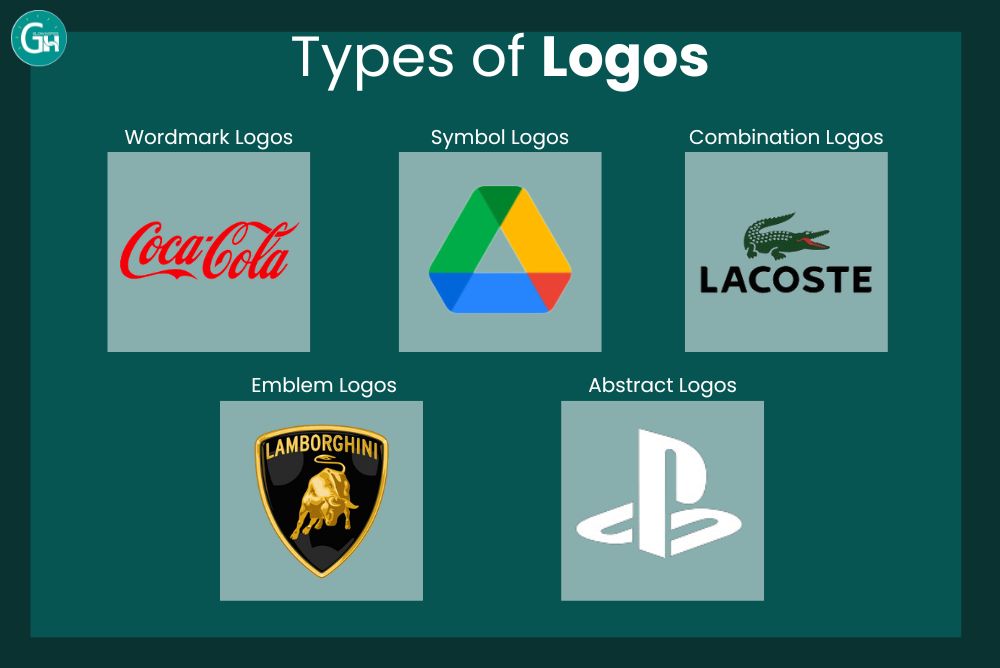Logos are important in visual branding because they express a company’s identity and ideals. There are types of logos. A well-designed logo has the potential to make a long lasting impression on customers and significantly impact a company’s success. In this blog post, we will look at the different types of logos, look at their key features, and provide examples that show each type. Before getting to know the types of logo, get to know about the Variations of logo in order to be thorough in your basics about logo designing.

What is a Logo?
Before we go into the types of logos, let’s define what a logo is. A logo is a graphic sign, emblem, or mark that is used to symbolise a brand or business. A logo is one of the very important aspects of branding in any business. It is a critical component in developing brand identity and increasing consumer recognition.
Exploring the Types of Logos

1. Wordmark Logos
Wordmark logos feature the brand’s name or a substantial portion of it in a distinct font or typographic style. These logos rely on literary elements to express brand identification. A classic example is the Coca-Cola logo, which features the brand name printed in a distinctive style.
Benefits:
- Memorability: Wordmark logos are generally memorable because of their unusual typography.
- Versatility: They can be simply tailored to various marketing materials.
Do’s::
- Select a unique and recognizable typeface that reflects your brand’s identity.
- Improve readability by ensuring correct spacing and lettering.
Don’ts:
- Avoid using sophisticated or decorative fonts that may impair readability.
- Say no to generic typefaces that do not contribute to the brand’s individuality

2. Symbol Logos
Symbol or icon logos contain a graphic or symbolic element that represents the brand without the need for language. Consider the iconic Apple logo: a basic apple with a bite taken out of it. Even without words, these logos effectively communicate brand identity.
Benefits:
- Scalability: Symbol logos are instantly recognizable at varied sizes.
- Versatility: They frequently transcend linguistic borders, making them widely understandable.
Do’s:
- Create a unique and specific emblem that embodies your brand’s personality.
- The logo should be identifiable at different sizes.
Don’ts:
- Minimise too detailed designs that may lose their effect when scaled down.
- Prevent symbols that have no relevance to your brand or sector.

3. Combination Logos
Combination logos, as the name implies, combine text and a symbol to form a complete representation of the brand. The Nike Swoosh, together with the brand name, is an excellent example of a combo logo. This font enables for versatility and identification in a variety of scenarios.
Benefits:
- Versatility: Combination logos offer the best of both worlds, combining text with a well-known symbol.
- Brand Cohesion:They provide a holistic portrayal of the brand..
Do’s:
- For a unified appearance, ensure that text and symbol are balanced.
- Choose features that complement one another and increase overall brand recognition.
Don’ts:
- Don’t overflow the design with too many details.
- Minimise items that clash and cause visual confusion.

4. Emblem Logos
Emblem logos incorporate the brand name into a symbol or image, resulting in a coherent design. These logos frequently have a traditional, authoritative sense. A good example is the Starbucks logo, which encapsulates both the mermaid motif and the brand name within a circular insignia.
Benefits:
- Authority: Emblem logos can convey a sense of continuity and authority.
- Coherence: The emblem combines all aspects to create a coherent, harmonious design.
Do’s:
- Make a balanced and symmetrical emblem for a clean look.
- Ensure that the emblem reflects the brand’s beliefs and industry.
Don’ts
- Minimise too complex emblems, which may lose clarity when modified.
- Avoid emblems that do not fit with the brand’s identity.

5. Abstract Logos
Abstract logos showcase the brand through unique, abstract shapes and forms. These designs frequently lack a direct relationship to the products or services supplied, instead focusing on creating a distinct visual character. The Adidas logo, with its characteristic three stripes, is a prime example of an abstract design.
Benefits:
- Uniqueness: Abstract logos distinguish the company by employing unusual shapes and forms.
- Versatility: They allow for a broad interpretation and application.
Do’s:
- Create a unique and memorable abstract form.
- Make sure that the concept remains connected to the brand’s identity.
Don’ts:
- Avoid overly complex abstract shapes that may be challenging to recognize.
- Steer clear of abstractions that lack any relevance to the brand.

The Impact of Logos on Business
The type of logo that a firm uses has a significant impact on its perception and success. A well-designed logo can increase brand recognition, build trust, and differentiate a company from its competitors. On the other side, a poor-quality or inaccurate logo can lead to misunderstanding and discourage brand growth.
1. Brand Recognition
Logos promote brand awareness by creating a visual identity that people can instantly associate with a specific business. This recognition is crucial to establishing trust and credibility in the business.
2. Establishing Trust
A professionally designed logo helps to maintain consumer trust and confidence. A visually appealing and well-executed logo reflects well on the brand, informing clients that the company is trustworthy and legitimate.
3. Differentiation
Logos distinguish a company from its competitors. In a crowded market, a distinctive and memorable logo identifies a brand, making it easier for customers to recognize and select it over competitors.
Conclusion
In conclusion, understanding the types of logos and their impact on business is critical for any brand seeking to develop a strong visual identity. Understanding the various sorts of logos, whether picking a wordmark, symbol, combination, emblem, or abstract logo, is critical for starting a firm. Canva is one of the best places to make your own logo. Businesses should carefully analyse their options to guarantee harmony with their brand values and goals. A well-crafted logo is more than just a symbol, it is a strong instrument that can influence consumers’ perceptions of a business.



